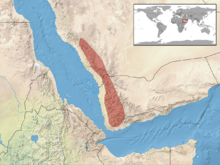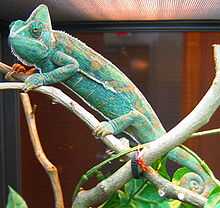Veiled chameleon
| Veiled chameleon | |
|---|---|
 | |
| female | |
| Conservation status | |
| Scientific classification | |
| Kingdom: | Animalia |
| Phylum: | Chordata |
| Class: | Reptilia |
| Order: | Squamata |
| Suborder: | Sauria |
| Family: | Chamaeleonidae |
| Genus: | Chamaeleo |
| Species: | C. calyptratus |
| Binomial name | |
| Chamaeleo calyptratus Duméril & Bibron, 1851 | |
 | |
The veiled chameleon (Chamaeleo calyptratus) is a species of chameleon native to the Arabian Peninsula in Yemen and Saudi Arabia. Other common names include cone-head chameleon and Yemen chameleon.[1]
Description
The male is 43 to 61 centimeters long from the snout to the tip of the tail. The female is shorter, no more than about 35 centimeters, but it has a thicker body. Both sexes have a casque on the head which grows larger as the chameleon matures, reaching about 5 centimeters in the largest adults. Newly hatched young are pastel green in color and develop stripes as they grow. Adult females are green with white, orange, yellow, or tan mottling. Adult males are brighter with more defined bands of yellow or blue and some mottling.[2]
Coloration can be affected by several factors, including social status. In experimental conditions, young veiled chameleons reared in isolation are darker and duller in color that those raised with other individuals.[3] Females change color across their reproductive cycles.[4] Chameleons also change color when stressed.[2]
Behavior and ecology
This chameleon lives in a number of habitat types in its native range, including plateaus, mountains, and valleys. Like other chameleons, it is arboreal, living in trees and other large plants. It prefers warmer temperatures, generally between 75° to 95°F (24° to 35°C).[2]
The veiled chameleon is an omnivore. It favors insects, and it also eats plant matter, especially as a source of water.[2]
The life span is about 5 years for females, and up to 8 years for males. They reach sexual maturity at four to five months. They breed more than once a year. The female lays large clutches of up to 85 eggs and buries them in sand. The eggs are white with a tough skin.[2] The embryos experience a diapause, a length of time when they are dormant in the egg before they begin developing. Increasing temperatures in the substrate initiate development.[5]
Males display for females during courtship, performing behaviors such as "head rolls" and "chin rubs". Females change color when they are receptive to breeding, and males are more likely to court them during this time.[4]
In captivity
The veiled chameleon is the most common Chamaeleo species in the pet trade. It is easy to breed and prolific in its egg production. It tolerates a range of conditions and survives well in captivity.[2]
Invasive species
This chameleon is an introduced species in Hawaii, where it is invasive in the local ecosystem. There is a breeding population established on Maui.[6] It can also be found in the wild in Florida, where escaped pets have established populations.[1]
Gallery
References
- ↑ 1.0 1.1 1.2 Wilms, T., R. Sindaco, and M. Shobrak. 2012. Chamaeleo calyptratus. The IUCN Red List of Threatened Species. Version 2014.2. Downloaded on 23 October 2014.
- ↑ 2.0 2.1 2.2 2.3 2.4 2.5 Veiled Chameleon. Smithsonian National Zoological Park.
- ↑ Ballen, C., et al. (2014). Effects of early social isolation on the behaviour and performance of juvenile lizards, Chamaeleo calyptratus. Animal Behaviour 88 1-6.
- ↑ 4.0 4.1 Kelso, E. C. and P. A. Verrell. (2002). Do male veiled chameleons, Chamaeleo calyptratus, adjust their courtship displays in response to female reproductive status? Ethology 108(6) 495-512.
- ↑ Andrews, R. M. and S. Donoghue. (2004). Effects of temperature and moisture on embryonic diapause of the veiled chameleon (Chamaeleo calyptratus). Journal of Experimental Zoology 301A 629-35.
- ↑ Detecting the Veiled Chameleon (Chamaeleo calyptratus) on Maui: Enhancing Control of an Injurious Species. First Progress Report. Maui Invasive Species Committee.
External links
| Wikimedia Commons has media related to Veiled chameleon. |
- Veiled Chameleon Care Sheet. The Lizard Lounge.
- Veiled Chameleon. Biotropics.com
Further reading
- Andrews, R. M. (2008). Effects of incubation temperature on growth and performance of the veiled chameleon (Chamaeleo calyptratus). Journal of Experimental Zoology Part A: Ecological Genetics and Physiology 309(8), 435-46.
- Herrel, A., et al. (2014). The scaling of tongue projection in the veiled chameleon, Chamaeleo calyptratus. Zoology 117 227-36.
- McCartney, K. L., et al. (2014). The effect of carotenoid supplementation on immune system development in juvenile male veiled chameleons (Chamaeleo calyptratus). Frontiers in Zoology 11 26.




